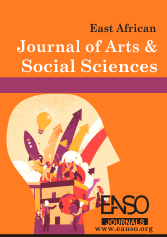Policy Implementation and Information Communication Technology Integration in Technical and Vocational Education and Training Institutions in Homa Bay County, Kenya
Abstract
The world is rapidly adopting ICT, and as it is now a basic element of high-quality education, ICT must be incorporated into education and training. This study looked into the policy implementation challenges concerning ICT integration in Homa Bay County. Through the governments, countries implement ICT policies aimed at achieving the high standard of education required for global competitiveness. The ICT policy in the education ministry has not been fully implemented in Homa Bay County's training institutions, particularly in the study's focus area of TVETs. This reduces the quality of education and training and subsequently the employability possibilities of the trainees in the aforementioned location by causing learning gaps between them and their peers in other places. Three theoretical frameworks—the Top-Down Approach, Street-Level Bureaucracy, and Stakeholder Management theories—shedding light on the hitches and procedures of implementing policies were the foundation of this study in line with the study’s goals. The study used a mixed-method approach for a population of 15085 drawn from the aforementioned institutions in Homa Bay County, with a sample of 384 respondents employing a multistage sampling technique. Closed-ended questionnaires and semi-structured interviews were utilised to gather data, and SPSS was used to display and analyse the data using descriptive analysis. The study showed that although ICT policies exist, implementation remains haphazard due to insufficient institutional capacity, poor stakeholder coordination, inadequate ICT infrastructure, and poor monitoring mechanisms. However, the adoption of ICT was highest at institutions where leadership was powerful, training was structured, and stakeholders were involved. The study then recommends from these results that institutional capacity can be fortified with continuous ICT training, collaborating with the stakeholders positively, investment in accessible infrastructure such as purpose-built internet connectivity, and laying down effective monitoring and evaluation frameworks. Sustainability requires that the government also strengthen its partnerships with the Non-Governmental organisations and the private sector. The result, moreover, gives useful suggestions to policymakers, educators, and stakeholders who wish to build a more digitally inclusive and effective learning environment throughout the educational institutions in the region
Downloads
References
Aklin, M. (2021). Inequality in Policy Implementation: caste and electrification in rural India. Journal of Public Policy 41 (2), 331-359.
Asongu, S. A., & Odhiambo, N. M. (2019). Enhancing ICT for quality education in sub - Saharan Africa. Education and information technologies 24, 2823-2839.
Azzasyofia, M., Adi, I. R., & Aritonang, A. N. (2020). The role of change agents in community empowerment using information and communication technology (ICT): A case study at Desa Kaliabu, Central Java. Indonesian Journal of Social Work 3(2).
Bariu, T. N. (2020). Status of ICT infrastructure used in teaching and learning in secondary schools in Meru. European Journal of Interactive Multimedia and Education 1 (1), e02002.
Chris, L. A. (2015). Barriers hindering implementation, innovation and adoption of ICT in Primary Schools in Kenya. International Journal of innovative research and development 4 (2), 2278-0211.
Freeman, E. R. (1984). Strategic Management: A Stakeholder Approach. Boston, MA: Pitman.
Field, A. (2018). Discovering statistics using IBM SPSS Statistics (5th ed). Sage Publications
Kidombo, H. J., Gakuu, C. M., & Ndiritu, A. (2012). Institutional management and integration of information and communication technology in teaching and learning in selected Kenyan schools. Journal of Continuing, Open and Distance Education, 151.
Makwambeni, P. R., Makwambeni, B., & Usadolo, S. E. (2023). An analysis of stakeholder engagement in the e -learning policy-making process at a higher education institution in South Africa. African Journal of Inter/Multidisciplinary Studies 5 (1), 1-13.
Matsiliza, N. (2019). Strategies to improve capacity for policy monitoring and evaluation in the public sector. Journal of Reviews on Global Economics 8, 490-499.
Mingaine, L. (2013). Leadership Challenges in the Implementation of ICT in Public Secondary Schools, Kenya. Journal of education and learning 2 (1), 32-43.
Murumba , J. W., Kimosop, M., Njoka , J., & Mwangi, G. R. (2023). Assessment of ICT integration in pedagogy in technical training institutions in Nyeri and Nairobi Counties, Kenya. African Journal of Education, Science and Technology 7 (3), 879-891.
Njoroge, F., Ngugi, M., & Kinzi, J. (2017). Influence of selected factors on the implementation of information and communication technology policy in public secondary schools in Naivasha Sub County, Kenya. International Journal of Education and Development using ICT 13 (2).
Nwokedi, O. C. (2018). Information and Communication Technology Capacity Building Skills of Education Lecturers in Universities in South-South Nigeria. Journal of Education in Developing Areas 26(1), 255-266.
OECD. (2020). ICT resources in school education: what do we know from OECD work.
Richardson, J., Sterrett, W., & Clemons, J. (2020). Technology and Stakeholder Engagement: Perspectives from the Top. Research in Educational Administration and Leadership 5 (4), 954-988.
Rosil, A. (2014). Explaining the gap between policy aspirations and implementation: The case of University Knowledge Transfer Policy in the United Kingdom. Birkbeck College, University of London.
Salman, I., Benyamin, P., & Wartoni, W. (2021). Monitoring model and evaluation of ICT utilization in the new normal era in distance learning in Madrasah. Proceedings of the 2nd International Conference on Religion and Education, INCRE 2020,11-12 November 2020.
UNESCO. (2014). UNESCO Education Strategy 2014- 2021. Paris: United Nations Educational, Scientific and Cultural Organization.
Copyright (c) 2025 Florence Akinyi Ojala, David M. Minja, PhD

This work is licensed under a Creative Commons Attribution 4.0 International License.




























